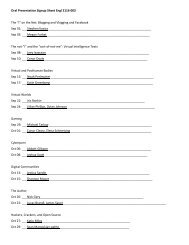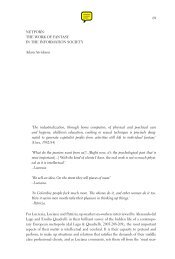Nakamura, Digitizing Race, Introduction, chapter 5, Epilogue
Nakamura, Digitizing Race, Introduction, chapter 5, Epilogue
Nakamura, Digitizing Race, Introduction, chapter 5, Epilogue
You also want an ePaper? Increase the reach of your titles
YUMPU automatically turns print PDFs into web optimized ePapers that Google loves.
The Social Optics of <strong>Race</strong> 119<br />
race in Minority Report. Optical scanners matched to networked databases<br />
can “see” who you are and can figure out what to sell you, as in the case of<br />
the Gap episode. However, other digital imaging applications, such as the<br />
technology that enables the Precognitives to project their visions of who<br />
will commit which murders onto giant cinema screens in the Precrime company’s<br />
“temple” brings to a mind another kind of computerized profiling that<br />
echoes the new social optics of race in America post 9/11: racial profiling.<br />
As the Newsweek critic David Ansen writes of Spielberg: “The director<br />
couldn’t have known...how uncannily [this] tale of 2054 Washington D.C.<br />
would resonate in the current political climate, where our jails fill up with<br />
suspects who’ve been arrested for crimes they haven’t yet committed.” 38<br />
The unprecedented access to the suspect’s personal information, remote<br />
geographic imaging, and militarized rapid response combined with the Precognitives’<br />
visions allow the police to concatenate multiple sources of visual<br />
and textual information together to profile people who are about to commit<br />
murders and arrest them before they can do so, without needing to go<br />
through anything but a pro forma trial via videoconference in advance of<br />
the crime, but after watching the footage. In other words, it works exactly<br />
as does the juridico-legal system in an informational post-terror state.<br />
“[Computers] simulate surveillance in the sense that they precede and<br />
redouble the means of observation. Computer profiling...is understood best<br />
not just as a technology of surveillance, but as a kind of surveillance in advance<br />
of surveillance, a technology of ‘observation before the fact.’” 39 The narrative<br />
of inadvertent cross-racial passing that is so much a part of Minority<br />
Report is enabled by the replacement of the physical body by the databody<br />
as a subject (and product) of surveillance. The retinal scanners read Anderton<br />
as Yakamoto because they are keyed to databases that look only at his<br />
eyes and the information that they are linked to. The science fiction film<br />
Gattaca (1997) extends the notion of dataveillance to the level of the gene,<br />
positing a future in which humans are heavily genetically engineered. 40 In<br />
“Closely Belated? Thoughts on Real-Time Media Publics and Minority Report,”<br />
Mark Williams draws connections between the film’s handling of<br />
time and prediction through data profiling and what he terms “real time<br />
desire.” Minority Report’s “belated thematics” or hypervaluation of mediated<br />
time shifting, as in the use of the personal video recorder or TiVo, is evident<br />
in the police’s possession of “the capacity to allow one to ‘freeze’ the ‘live’<br />
image, and then fast-forward through ‘real time’ to the now, and resynchronize<br />
with the ‘live,’ represents[ing] the newest wrinkle of temporal frenzy<br />
within mediated culture.” 41 These scenes of mediated video manipulation





